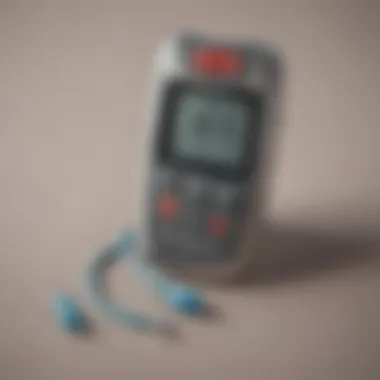Understanding Non-Invasive Glucose Meter Pricing


Intro
The landscape of health monitoring has evolved with significant advancements in technology. One remarkable innovation in this field is the non-invasive glucose meter. This device allows individuals with diabetes or those monitoring their glucose levels to manage their health without the discomfort associated with traditional blood tests. However, while the functionality of these devices is crucial, understanding their pricing structure is equally important.
This article delves into the pricing of non-invasive glucose meters. It examines several key factors that influence the costs associated with these devices. Additionally, it explores the variety of models available in the market and how consumer choices are shaped by these price variations.
Learning about the pricing landscape informs consumers and researchers about what to expect regarding affordability and access to these essential health tools. As we move forward, it becomes imperative to understand how these technological innovations impact pricing trends, availability, and ultimately healthcare economics.
Key Findings
Summary of the main results
The analysis reveals that the price of non-invasive glucose meters can vary considerably based on several factors:
- Technology Used: The type of technology integrated into the device, such as spectroscopy or radio waves, plays a significant role in pricing.
- Brand Reputation: Well-known brands tend to price their products higher, reflecting their research investments and trust among consumers.
- Market Competition: The presence of multiple manufacturers can lead to price variations as companies compete for market share.
- Additional Features: Devices offering extra functionalities, such as data tracking and integration with mobile applications, are often priced higher than basic models.
Significance of findings within the scientific community
The findings of this research contribute to ongoing discussions within the scientific community. As non-invasive glucose meters represent a step forward in diabetes management, understanding their pricing can influence future development and accessibility. The investment in research and development required to bring such technologies to market can drive prices higher. Therefore, insights from this analysis can aid stakeholders in making informed decisions about which products to develop and how to price them effectively.
Implications of the Research
Applications of findings in real-world scenarios
The implications of pricing insights extend beyond consumer awareness. Healthcare practitioners and policymakers can apply these findings to enhance patient care. As non-invasive glucose meters evolve, understanding the economic aspects can facilitate access for more patients. Pricing transparency may encourage insurance companies to cover such devices, improving overall health outcomes.
Potential impact on future research directions
This research can serve as a foundation for further studies on the economic viability of non-invasive glucose monitoring solutions. As technology advances, future research could explore the impact of innovations on pricing, helping to create more affordable options. These insights could also promote discussion about health equity and access to essential health monitoring technologies, ensuring that all patients benefit from significant advancements.
Prelude to Non-Invasive Glucose Meters
Non-invasive glucose meters are becoming increasingly relevant in today's healthcare landscape. Thier development represents a significant advancement in diabetes management. Patients no longer need to prick their fingers for blood samples, which has historically been a pain point in glucose monitoring. The convenience offered by these devices has implications for better patient compliance and overall health management.
This analysis will explore various aspects of non-invasive glucose meters, such as their definition, historical context, and the significance of their adoption. Understanding these elements sets the groundwork to discuss the pricing landscape and the factors that influence costs in this emerging market.
Definition and Overview
Non-invasive glucose meters are devices designed to estimate blood glucose levels without the need for skin puncture. They typically utilize different technologies, such as optical sensing and electromagnetic waves, to measure glucose concentrations. These technologies enable readings to be taken without the traditional blood samples. This approach is particularly appealing for individuals who require frequent glucose monitoring, such as those with diabetes.
The ability of non-invasive meters to provide real-time data quickly enhances the user's ability to make informed health decisions. They can also reduce the risks associated with invasive methods, such as infection or discomfort.
Historical Context of Glucose Monitoring
Glucose monitoring has evolved significantly since its inception. The first glucose meters, introduced in the 1960s, relied on complex chemical reactions and required blood samples. Advances in technology brought about more user-friendly devices, leading to the widespread acceptance of fingerstick meters in the late 20th century.
In recent years, researchers have focused on non-invasive methods, motivated by the need for less painful alternatives. Several prototypes of non-invasive meters have emerged, showcasing varying degrees of accuracy and user comfort. However, the journey from innovative concept to market-ready product has been fraught with challenges, including achieving regulatory approvals, ensuring accuracy, and maintaining cost-effectiveness.
"Understanding the evolution of glucose monitoring is crucial for appreciating the current landscape and future innovations."
In summary, this section lays the framework for the subsequent exploration of non-invasive glucose meter pricing. By comprehending the definitions and historical developments, readers can better grasp the market conditions and factors influencing pricing.


Importance of Non-Invasive Glucose Measurement
Non-invasive glucose meters play a pivotal role in diabetes management and care. This aspect is critical as it touches the lives of millions who require regular monitoring of blood sugar levels. The convenience of these devices brings significant health-related benefits and has positive implications for patient compliance. Understanding this importance can shed light on why pricing strategies should consider both the technology's value and user expectations.
Health Benefits and Patient Compliance
Non-invasive glucose measurement presents an attractive alternative for patients. Traditional methods like fingerstick testing can be a daunting process. The anxiety and discomfort associated with needles often lead to non-compliance. On the other hand, non-invasive devices offer a painless way to monitor blood sugar, encouraging more individuals to check their levels regularly.
The use of non-invasive glucose meters not only fosters adherence to monitoring routines but can also potentially improve overall health outcomes. Studies suggest that patients who measure their glucose levels more frequently are better equipped to manage their diabetes. They can adjust their diets and medication more effectively, leading to reduced incidences of hyperglycemia and hypoglycemia. Maintaining stable glucose levels minimizes the risk of complications such as neuropathy, retinopathy, and cardiovascular diseases. In essence, this technology could act as a catalyst for a healthier lifestyle.
Reducing Pain and Inconvenience
The pain and inconvenience posed by conventional glucose monitoring methods cannot be overstated. Non-invasive meters eliminate the need for blood samples, which originally represented a barrier for many patients. This advancement significantly reduces the psychological burden, particularly for those inexperienced in the management of diabetes or those with a strong aversion to needles.
Moreover, the ease of use associated with non-invasive meters can increase accessibility for patients of all ages. More intuitive designs allow for users to check their glucose levels quickly and efficiently, without the logistical challenges of gathering supplies or dealing with blood.
For patients with busy lifestyles, non-invasive devices can integrate seamlessly into their daily routines, promoting a proactive approach towards their health management. The time saved from frequent testing can also encourage more open discussions regarding their diabetes care among patients and healthcare providers, fostering a collaborative relationship crucial for effective disease management.
"Incorporating non-invasive glucose monitoring into diabetes care has the potential to transform patients' interactions with their health."
The ongoing innovations in non-invasive measurement technologies indicate a future with even fewer hurdles for patients. As more individuals adopt these solutions, the healthcare system could see a shift in the approach towards diabetes care, potentially lowering overall healthcare costs.
In summation, the importance of non-invasive glucose measurement is multifaceted. It benefits patient compliance, health outcomes, and the overall quality of life for those managing diabetes. As we further explore the pricing of these devices, it’s crucial to understand the value they provide beyond mere numbers.
Current Market Landscape
The current market landscape for non-invasive glucose meters is critical to understanding pricing dynamics within this segment. It sheds light on various factors such as competition, technological advancements, and consumer preferences. A comprehensive overview of this landscape informs potential buyers about product availability, helps them navigate the complexities of pricing strategies employed by different brands, and highlights the shifting trends in response to market demands.
Key Players in the Industry
The non-invasive glucose meter market consists of several key players that lead the industry through innovation and product development. Companies like Abbott Laboratories, Medtronic, and GlucoMe play a significant role in shaping the market through their research initiatives and advanced technologies.
These companies contribute not only to technological improvements but also to building brand reputation. Their reputation influences consumer choices and pricing. As consumers obviously prefer well-established brands, the market observes pronounced differences in pricing based on brand credibility. New entrants also attempt to penetrate the market, presenting innovative solutions that may disrupt established pricing structures. This creates a dynamic where both well-known and emerging brands coexist, impacting pricing based on quality, features, and technology.
Emerging Technologies and Innovations
Emerging technologies in non-invasive glucose monitoring promise to redefine accessibility and convenience for users. Innovations such as continuous glucose monitoring systems and wearable sensors are at the forefront. These devices utilize advanced algorithms and biosensors to make glucose monitoring seamless, without the need for finger pricks.
As these technologies advance, they often introduce complexity that can affect pricing strategies. For instance, devices harnessing optical sensing or ultrasound require significant development investment, which reflects in their final price.
Key points about emerging technologies include:
- Enhanced accuracy and reliability
- Reduced size and increased portability of devices
- Integration with mobile applications for real-time monitoring
These advancements not only cater to the growing consumer demand but also align with regulatory expectations, and may significantly affect the overall market landscape by offering lower-cost alternatives over time.
Factors Affecting Pricing of Non-Invasive Glucose Meters
The pricing of non-invasive glucose meters is a complex issue influenced by multiple factors. Understanding these influences can assist consumers, healthcare providers, and stakeholders in making informed decisions. This section outlines the primary aspects that contribute to the costs associated with non-invasive glucose measurement technologies.
Technology and Development Costs


The technological underpinnings of non-invasive glucose meters play a significant role in determining their pricing. These devices employ sophisticated optical, electromagnetic, or thermal methodologies to accurately gauge glucose levels without the need for blood samples.
Developing such technology demands extensive research and development investment. Companies like Senseonics and Glucometer are at the forefront of this innovation, yet the financial burdens incurred during testing phases, prototyping, and later productions can affect the initial pricing for consumers.
Moreover, the cost of raw materials and components, including advanced sensors and durable materials, also adds to the overall expense. Manufacturers often aim to recoup these costs through pricing strategies that balance affordability with profitability.
Regulatory Considerations and Approval Processes
Regulatory frameworks govern how medical devices, including glucose meters, can enter the market. Compliance with strict quality and safety standards like those set by the U.S. Food and Drug Administration (FDA) impacts manufacturer expenses. The process involves extensive testing and documentation, which can be time-consuming and costly.
Additionally, obtaining approvals may require multiple iterations of device design, leading to increased research and production costs. These added expenses are often reflected in the final market price. It is essential for consumers to recognize that a higher price may sometimes correlate with enhanced safety and efficacy as mandated by regulatory bodies.
Brand Recognition and Market Demand
Brand perception can significantly influence the pricing of non-invasive glucose meters. Established brands, such as Abbott and Dexcom, tend to command higher prices due to their reputation for quality and reliability. Consumers often associate higher-priced products with being more advanced or effective.
Conversely, emerging brands may adopt lower pricing strategies to penetrate the market and attract consumers. This price elasticity depends on market demand, which fluctuates based on consumer preferences, availability, and economic factors troubling the healthcare field.
To summarize, factors like technology development costs, regulatory hurdles, and brand dynamics converge in various ways to shape the pricing landscape of non-invasive glucose meters. Understanding these elements enables stakeholders to make educated choices in the marketplace.
Comparative Analysis of Non-Invasive Glucose Meter Prices
The comparative analysis of non-invasive glucose meter prices is a crucial aspect of understanding the market landscape. With a range of products available, consumers must discern the best value among various options. It allows potential buyers to make informed decisions based on their health needs and financial constraints. Additionally, this analysis can inform manufacturers about market trends and consumer preferences, guiding future product development.
Overview of Different Brands and Models
In the market for non-invasive glucose meters, several brands stand out due to their technological advancements and unique features. Among them are Abbott FreeStyle Libre, Glucomen Day, and NemaSense. Each of these brands offers a distinct approach to glucose monitoring. For example, Abbott's FreeStyle Libre uses a sensor applied to the skin that continuously monitors glucose levels, providing real-time data.
Key brands include:
- Abbott - Known for ease of use and innovative technology.
- Glucomen - Offers a range of models that focus on precision and reliability.
- NemaSense - Pioneering in non-invasive methods and offering varied functionalities.
Each brand has its own set of models with differing capabilities, designed for diverse consumer needs. This variety underscores the importance of understanding specific characteristics and consumer requirements.
Price Ranges and Accessibility
The price range for non-invasive glucose meters varies significantly, generally starting around $50 and going up to $400 or more, depending on features and technology. Factors influencing these prices include:
- Technology used - More advanced sensors tend to be more expensive.
- Brand reputation - Established brands may charge higher prices due to perceived reliability.
- Market demand - Growing interest in diabetes management can influence pricing dynamics.
Accessibility is another critical factor. Some models may not be available through all retailers or might require a prescription, which could limit consumer access. In contrast, others may be readily available online or at local pharmacies, ensuring a wider reach. Consumers must evaluate their options and consider their individual needs and situations.
With the right information, consumers can navigate this landscape effectively, optimizing both their health management and financial considerations.
"Understanding price variations helps consumers choose the right glucose monitoring solution while considering both affordability and efficacy."
This comparative analysis lays a foundation for consumers, equipping them with the knowledge needed to select the right non-invasive glucose meter that aligns with their lifestyle and budget.
Consumer Perspectives on Pricing
Understanding consumer perspectives on pricing is vital to comprehend the dynamics that drive market trends for non-invasive glucose meters. The affordability and accessibility of these meters significantly impact patient adherence to management plans. As healthcare evolves, the role of patients in decision-making has grown. Patients not only assess the clinical effectiveness of glucose meters but also their costs, coverage by insurance, and overall usability.


Patient Feedback and User Experiences
Patient feedback provides crucial insights into the strengths and weaknesses of various glucose monitoring devices. Users often share their experiences through online forums or direct consumer reviews. This feedback reflects individual experiences, including ease-of-use, accuracy of readings, and overall satisfaction with the product.
Key points from user experiences include:
- Ease of Use: Patients frequently emphasize how intuitive a device is to operate. User-friendly interfaces can lead to better adherence.
- Accuracy: Many users value accuracy above all. They often report on how reading discrepancies can affect their treatment plans and trust in the device.
- Durability and Portability: Consumer reviews also reveal the need for meters that withstand daily usage and can be easily carried around, as users often want to monitor their glucose levels while on the go.
Such feedback can influence future product designs and pricing strategies. This dynamic feedback loop enables manufacturers to align their offerings with consumer needs.
Insurance Coverage and Out-of-Pocket Costs
Insurance coverage plays a significant role in determining how accessible non-invasive glucose meters are to patients. Many patients find these devices expensive, especially if they are not covered by their insurance plans. Out-of-pocket costs can vary widely across regions and insurance policies, affecting purchase decisions.
Important elements to consider include:
- Policy Variations: Some insurers may provide better coverage for specific brands or types of meters, creating disparities in financial burden for patients.
- Co-Payments: The financial responsibility of payers often extends beyond initial costs. Co-payments can significantly influence whether a patient opts for a non-invasive device or opts for traditional meters.
- Accessibility: In some cases, public health programs may subsidize costs for eligible patients, further affecting overall market dynamics.
"Understanding insurance limitations is crucial for consumers. It can determine whether they can afford a non-invasive glucose meter or revert to the older painful methods of monitoring their health."
Future Trends in Non-Invasive Glucose Monitoring
The future of non-invasive glucose monitoring holds exceptional promise. As technology progresses, we can expect a range of developments that will enhance user experience and accessibility. This section dives into likely technological advancements and their implications on pricing strategies in the marketplace.
Predicted Developments in Technology
The technological innovations in the realm of non-invasive glucose meters are set to transform the way we monitor blood glucose levels. One key area is the integration of artificial intelligence and machine learning algorithms. These technologies can analyze data more efficiently, providing users with real-time insights and predictive analytics.
Moreover, miniaturization is another important trend. This leads to devices that are not only more portable but also more user-friendly. Traditional glucometers often require multiple and sometimes painful pricks. In contrast, devices like the Abbott FreeStyle Libre use sensors that are applied to the skin, significantly reducing discomfort.
Additionally, an increase in connectivity options, such as Bluetooth and mobile applications, allows users to track their glucose levels directly from their smartphones. This connectivity enables seamless sharing of data with healthcare providers, fostering better management of diabetes.
"Technological advancements promise a future where glucose monitoring is less invasive and more integrated into daily life."
Potential Impact on Pricing Strategies
As technology advances, pricing strategies for non-invasive glucose meters are also likely to change. Initially, new technologies tend to be premium-priced due to high development costs. However, as production scales and competition increases, prices typically decrease. This cycle can make non-invasive glucose meters more accessible to a broader audience.
Moreover, advancements in manufacturing techniques could lead to lower production costs, enabling companies to offer competitive pricing without compromising quality. For instance, companies focused on sustainable practices may find ways to reduce costs while appealing to environmentally conscious consumers.
Finale
The topic of non-invasive glucose meter pricing is crucial for understanding the broader landscape of diabetes management technologies. It emphasizes various specific elements of the situation, including how technological advancements, regulatory frameworks, and market dynamics impact affordability and accessibility. By analyzing the pricing of these devices, we gain insights into their economic implications for patients and healthcare systems.
In this article, we have explored the varied aspects influencing costs associated with non-invasive glucose meters. The intersection of innovation and affordability creates a narrative that is both complex and significant. The benefits of pricing transparency and the availability of affordable solutions can significantly impact patients' willingness to adopt new technologies.
Prices vary widely, influenced by factors such as development costs, brand equity, technology, and market competition. As such, understanding these pricing structures can lead to better decision-making for both consumers and professionals involved in healthcare.
Key Insight: The evolving technology landscape not only provides new solutions but also raises the discourse on pricing fairness in healthcare.
Summary of Key Points
- Technological Impact: Advances in non-invasive glucose monitoring significantly affect pricing.
- Market Landscape: An overview of brands and models reveals a range of prices, which can affect consumer choices.
- Consumer Insights: Feedback from users offers perspective on the perceived value of non-invasive options.
- Future Trends: Predictions about technological improvements suggest potential shifts in pricing strategies.
- Economic Considerations: Insurance coverage and out-of-pocket costs are vital for patient access to these devices.
Final Thoughts on Non-Invasive Glucose Meter Pricing
As we reflect on the pricing of non-invasive glucose meters, it is evident that several factors contribute to how these products are positioned in the market. Brand recognition plays a significant role in shaping consumer perception, while regulatory processes may affect the pace at which new technologies reach the public.
Moreover, access to accurate information regarding pricing is essential. Consumers need to be informed of their options to make choices that align with their health needs and financial situations. The evolution of non-invasive glucose meters stands at a compelling intersection of technology, market demand, and patient welfare. Continuous monitoring of these trends is necessary to ensure that advancements benefit all users across the spectrum of health needs.







